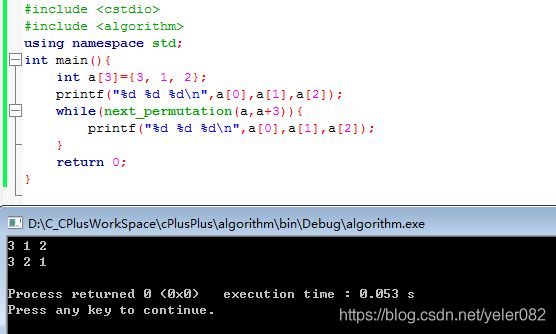C++ #include
标准模板库:算法
头文件
范围是可以通过迭代器或指针访问的任何对象序列,例如数组或某些STL容器的实例。 但是请注意,算法通过迭代器直接对值进行操作,而不以任何方式影响任何可能容器的结构(它从不影响容器的大小或存储分配)。
参考手册:cplusplus.com
具体包括 1、非修改序列操作 2、修改序列的操作 3、分区操作 4、排序操作 5、二分查找操作 6、合并操作
7、堆操作 8、最大最小值操作 9、其它操作
这里列举几个常见操作:
1、reverse()
// reverse algorithm example
#include // std::cout
#include // std::reverse
#include // std::vector
int main () {
std::vector myvector;
// set some values:
for (int i=1; i<10; ++i) myvector.push_back(i); // 1 2 3 4 5 6 7 8 9
std::reverse(myvector.begin(),myvector.end()); // 9 8 7 6 5 4 3 2 1
// print out content:
std::cout << "myvector contains:";
for (std::vector::iterator it=myvector.begin(); it!=myvector.end(); ++it)
std::cout << ' ' << *it;
std::cout << '\n';
return 0;
}
2、next_permutation(),返回大于等于当前序列的全排列
#include
#include
using namespace std;
int main(){
int a[3]={1, 2, 3};
printf("%d %d %d\n",a[0],a[1],a[2]);
while(next_permutation(a,a+3)){
printf("%d %d %d\n",a[0],a[1],a[2]);
}
return 0;
}
如果将输入序列变成,3, 1, 2 ,那么最后全排列的结果就发生了变化
3、sort()
// sort algorithm example
#include // std::cout
#include // std::sort
#include // std::vector
bool myfunction (int i,int j) { return (i myvector (myints, myints+8); // 32 71 12 45 26 80 53 33
// using default comparison (operator <):
std::sort (myvector.begin(), myvector.begin()+4); //(12 32 45 71)26 80 53 33
// using function as comp
std::sort (myvector.begin()+4, myvector.end(), myfunction); // 12 32 45 71(26 33 53 80)
// using object as comp
std::sort (myvector.begin(), myvector.end(), myobject); //(12 26 32 33 45 53 71 80)
// print out content:
std::cout << "myvector contains:";
for (std::vector::iterator it=myvector.begin(); it!=myvector.end(); ++it)
std::cout << ' ' << *it;
std::cout << '\n';
return 0;
} 为了展示sort的实际应用场景,这里再加一个案例。
设计一个英雄的结构体,包括成员姓名,年龄,性别;创建结构体数组,数组中存放5名英雄。
通过冒泡排序的算法,将数组中的英雄按照年龄进行升序排序,最终打印排序后的结果。
五名英雄信息如下:
{"刘备",23,"男"},
{"关羽",22,"男"},
{"张飞",20,"男"},
{"赵云",21,"男"},
{"貂蝉",19,"女"},
首先定义Hero.h
#pragma once
#ifndef HERO_TYPE_01_
#define HERO_TYPE_01_
#include
#include
struct Hero
{
std::string name;
int age;
bool sex;
};
void sort_hero(Hero heros[], int len);
void print_hero_list(Hero heros[], int len);
#endif
然后是Hero.cpp关于Hero.h的实现
# include "hero.h"
# include
# include
bool myfunc(Hero HA, Hero HB)
{
return HA.age > HB.age;
}
void sort_hero(Hero heros[], int len)
{
// 定义一个vector向量,将结构体的数据放入到vector,在algorithm的参数里面要求为Random-access iterators
std::vectorvec_heros(heros, heros + len);
// 通过内置算法进行排序
std::sort(vec_heros.begin(), vec_heros.end(), myfunc);
// 将排序的vector结果拷贝给heros数组
for (size_t i = 0; i < len; i++)
{
heros[i] = vec_heros[i];
}
}
void print_hero_list(Hero heros[], int len)
{
for (size_t i = 0; i < len; i++)
{
std::cout << "name=" << heros[i].name << " age=" << heros[i].age << " sex=" << heros[i].sex << std::endl;
}
} 主函数
#include
#include "hero.h"
using namespace std;
int main()
{
struct Hero heros[5] = {
{ "刘备",23,"男" },
{ "关羽",22,"男" },
{ "张飞",20,"男" },
{ "赵云",21,"男" },
{ "貂蝉",19,"女" },
};
int len = sizeof(heros) / sizeof(Hero); //获取数组元素个数
sort_hero(heros, len); //排序
print_hero_list(heros, len); //打印
system("pause");
return 0;
} 



